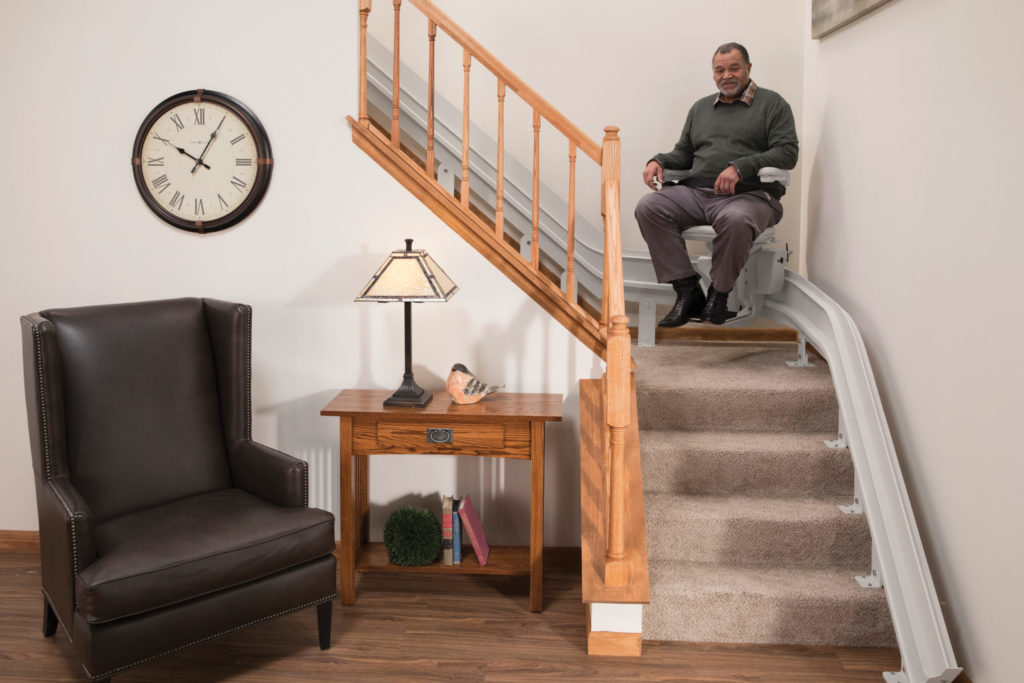
What are stairlifts and how do they work?
Stairlifts are battery-powered chairs that move up and down your staircase on a stair-mounted rail. Stairlift designs typically have a comfortable riding seat and are available in chargeable or remote operational features. Stairlifts can be installed indoors, outdoors, and are either straight or curved depending on the stairwell shape. More detailed information about the variety of stairlifts styles offered by UDS can be found on the UDS services page for home modifications.
Who may benefit from a stairlift?
Individuals who struggle with movement, balance, strength, and stability as it pertains to walking up and down stairs freely and without assistance are candidates for having stairlifts installed in their homes. They allow for a sense of independence for individuals who struggle with certain mobility limitations yet want to stay in place. In addition, they provide a level of ease and security with safety sensors.
Stairlifts are suitable for the elderly, those with disabilities, and those recovering from injuries. The following is a list of common reasons for individuals to install a stairlift in their home:
- Seniors – If you’re a senior and want to remain at home to live more independently, having a stairlift provides a solution so you can navigate your home without having to live on a single floor. This provides the flexibility to make all the rooms in your home more accessible.
- Multiple Sclerosis – If you have a degenerative muscular disease such as MS, you may struggle with balance and stability while walking. Having a stairlift can reduce risk of accidents or injury by providing a safe way to go from one floor to the next.
- Spinal Cord Injuries or other forms of neuropathy – Neuropathy, which is a result of damage to the nerves located outside of the brain and spinal cord, often causes weakness, numbness and pain, usually in the hands and feet. A stairlift is appropriate if you have enough mobility to get in and out of the secured chair seat on your own.
- Arthritis – If you suffer from rheumatoid or osteoarthritis, you feel the swelling and, often, extreme pain associated with the disease. Having a stairlift can alleviate some of these symptoms by reducing the stress placed on your bones and joints as you walk up and down stairs.
- Diabetes – If you have diabetes and have been affected by amputations or obesity due to the disease, a stairlift is one of the best solutions to assist with relieving the aches and pains and mobility issues that go along with making even the simplest of activities challenging.
Is a stairlift right for you?
Stairlifts are a great solution for those challenged with mobility issues yet want to maintain independence with less reliance on caretakers or family members. They alleviate some of the discomfort for those who experience pain walking up and down stairs. Stairlifts for those with disabilities and aging individuals provide access to levels of their home whereas they would otherwise be forced to avoid altogether.
With these benefits in mind, however, installing a stairlift is a major investment. Consider the following before deciding if a stairlift is right for you:
- Stairlifts are suitable for people who can walk short distances but struggle navigating stairs. If you have difficulty walking without additional assistance, this may not be the right choice – unless you have support that can help once you’ve reached the next floor.
- You need to be able to get into the stairlift chair safely. If you aren’t able to sit by bending your knees you would have difficulty using one.
- Stairlifts have controls to maneuver the mechanisms. Do you have enough manual dexterity to push buttons or use a joystick or toggle?
- Is your disability stable or transitory? If you’ve suffered a stroke, have arthritis, are recovering from major surgery, or have complications from diabetes, or other mobility challenges, a stairlift can make a dramatic difference in your quality of life.
- While canes and walkers are stable enough for flat surfaces, do you find yourself struggling to walk up and down stairs safely? If you have difficulty navigating stairs with a cane or walker, having a stairlift can offer a way to get to areas only accessible by steps.
- Think about how many times you need to go up and downstairs. Tripping on stairs can pose a risk to anyone with mobility issues. Are you at a higher risk of falling downstairs as your mobility declines? To gain access to other parts of the home for safety concerns, a stairlift is a good solution for these circumstances.
There may also be options and alternatives to a stairlift.
If now is not the time to install a stairlift there may be other accessible in-home modifications that can be done to make your main floor an adequate living space that can still meet your needs. At UDS, we have an extensive knowledge of home modifications specific to individuals with varying disabilities and may be able to help you understand and create other options if a stairlift isn’t the right fit. Of course, we can also help with a stairlift and make sure that it works best for your specific situation.
Regardless of what is inhibiting your mobility, UDS is available to serve your in-home modification and stairlift needs. Located in the Lancaster, PA area and surrounding areas, UDS takes the utmost pride and care in ensuring that you are fitted with the most appropriate and best suited stairlift for you and your lifestyle.
Before installing your stairlift, UDS will complete an in-home evaluation, and install and service your lift. This also includes a manufacturer’s warranty on parts and a one-year labor warranty guarantee.
Don’t let a flight of stairs diminish your independence. If you need stairlift assistance and are in the greater Pennsylvania area, Contact UDS for more information.